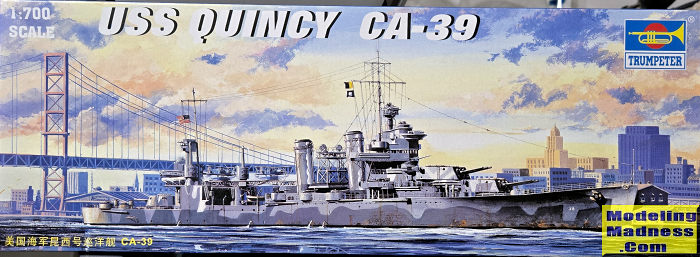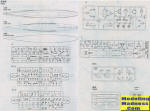
Trumpeter 1/700 USS Quincy (CA 39)
| KIT #: | 05748 |
| PRICE: | $10.00 'used' |
| DECALS: | Three ships |
| REVIEWER: | Scott Van Aken |
| NOTES: | 2007 release |

| HISTORY |
The USS Quincy was a New Orleans-class cruiser that were the last US cruisers built to the specifications and standards of the Washington Naval Treaty of 1922. Such ships, with a limit of 10,000 tons standard displacement and 8-inch caliber main guns, may be referred to as "treaty cruisers." Originally classified a light cruiser when she was authorized, because of her thin armor, she was reclassified a heavy cruiser, because of her 8-inch guns. The term "heavy cruiser" was not defined until the London Naval Treaty in 1930. This ship and Vincennes were a slightly improved version of the New Orleans-class design.
For the invasion of Guadalcanal, Quincy was reassigned from the Atlantic fleet to the Pacific. While on patrol in the channel between Florida Island and Savo Island, in the early hours of 9 August 1942, Quincy was attacked by a large Japanese naval force during the Battle of Savo Island.
Quincy, along with sister ships USS Astoria (CA-34) and USS Vincennes (CA-44), had seen aircraft flares dropped over other ships in the task force, and had just sounded general quarters and was coming alert when the searchlights from the Japanese column came on. Quincy's captain, Samuel N. Moore, gave the order to commence firing, but the gun crews were not ready. Within a few minutes, Quincy was caught in a crossfire between Aoba, Furutaka, and Tenryū, and was hit heavily and set afire. Quincy's captain ordered his cruiser to charge towards the eastern Japanese column, but as she turned to do so Quincy was hit by two torpedoes from Tenryū, causing severe damage. Quincy managed to fire a few main gun salvos, one of which hit Chōkai's chart room 6 meters (20 ft) from Admiral Mikawa and killed or wounded 36 men, although Mikawa was not injured. At 02:10, incoming shells killed or wounded almost all of Quincy's bridge crew, including the captain. At 02:16, the cruiser was hit by a torpedo from Aoba, and the ship's remaining guns were silenced. Quincy's assistant gunnery officer, sent to the bridge to ask for instructions, reported on what he found:
"When I reached the bridge level, I found it a shambles of dead bodies with only three or four people still standing. In the Pilot House itself the only person standing was the signalman at the wheel who was vainly endeavoring to check the ship's swing to starboard to bring her to port. On questioning him I found out that the Captain, who at that time was laying [sic] near the wheel, had instructed him to beach the ship and he was trying to head for Savo Island, distant some four miles (6 km) on the port quarter. I stepped to the port side of the Pilot House, and looked out to find the island and noted that the ship was heeling rapidly to port, sinking by the bow. At that instant the Captain straightened up and fell back, apparently dead, without having uttered any sound other than a moan."
Quincy sustained many direct hits which left 370 men dead and 167 wounded. She sank, bow first, at 02:38, being the first ship sunk in the area which was later known as Ironbottom Sound.
| THE KIT |
 Trumpeter
has provided a number of ship kits in various scales over the years and this
is one of them. The general molding of the parts is very good and there are
enough small parts to keep any ship modeler happy for quite a while. The kit
can be built as a waterline model or with a full hull. The main hull is well
reinforced to accept the two main deck pieces. The deck mounted turrets have
captive grommets so that they can rotate. Each of the main gun barrels is
separate and includes the blast bags. Holes for the turret top items will
need to be opened prior to assembly,
Trumpeter
has provided a number of ship kits in various scales over the years and this
is one of them. The general molding of the parts is very good and there are
enough small parts to keep any ship modeler happy for quite a while. The kit
can be built as a waterline model or with a full hull. The main hull is well
reinforced to accept the two main deck pieces. The deck mounted turrets have
captive grommets so that they can rotate. Each of the main gun barrels is
separate and includes the blast bags. Holes for the turret top items will
need to be opened prior to assembly,
Then begins the slow construction of the various deck sections along with whatever bits and pieces will fit either on them or atop them. Things like life rafts, ship's boats, AA guns, ladders and the such need to be attached. But before thos items are actually glued in place, the main deck gets its share of bits and pieces again, including searchlight toweres, AA guns and tubs, ship's boats, depth charge racks and other items. As work continues, items like catapults, masts, cranes, and stacks will need to be added. An SOC floatplane is also included. For the final step, one chooses between leaving it as a waterline model or adding the lower hull along with props and rudders. A display stand for the latter choice is included.
Instructions are well drawn and easy to follow. A separate camouflage and markings sheet in full color is provided. You have the option of ship's numbers for the San Francisco and Vincennes as well as the Quincy provided on the sheet. There are also insignia for the floatplane along with flags.
| CONCLUSIONS |
This looks like a very nice kit and while ships are really not my thing, it appears that it will make into a very nice model. Well worth picking up if you are a ship modeler.
| REFERENCES |
https://en.wikipedia.org/wiki/USS_Quincy_(CA-39)
February 2025
Copyright ModelingMadness.com. All rights reserved. No reproduction in part or in whole without express permission.
If you would like your product reviewed fairly and fairly quickly, please contact the editor or see other details in the Note to Contributors.